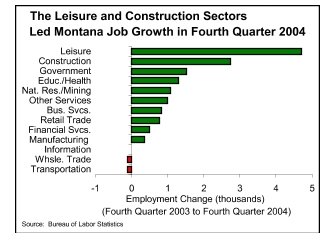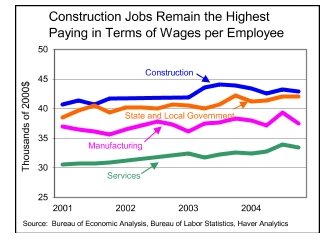

|
| weblog/wEssays archives | home | |
|
What Happens When Housing Employment Plummets? (June 13, 2006)  UCLA's Anderson Forecast predicts 800,000 jobs will be lost as the housing bubble
bursts. A look at the actual numbers suggest they've grossly under-estimated the real damage to come.
UCLA's Anderson Forecast predicts 800,000 jobs will be lost as the housing bubble
bursts. A look at the actual numbers suggest they've grossly under-estimated the real damage to come.
Here is what CNN's story There go 800,000 jobs out the door had to say: The report, released Wednesday, forecast a loss of 500,000 construction jobs and 300,000 jobs in the financial services sector from the housing slowdown, but noted that job losses would not spread across many industries, other than some limited pullbacks in manufacturing.Before we accept the improbably low number of 800,000 jobs lost, let's take a look at the size of the construction industry and its subsidiaries. There's no better place to start than the Bureau of Labor Statistics job report: out of total Durable goods employment of 8,970: out of total retail employment of 15,300: out of services employment: To get a picture of how many construction jobs fall into "heavy construction" such as infrastructure projects, we can guessimate that employment by ascertaining how many union workers are in the construction workforce. Since heavy construction work is largely union, while residential is largely non-union, these numbers from the Associated General Contractors job report tell the story: BLS reported on January 20 that Union membership fell from 1,110,000 out of 7,550,000 construction employees (14.7%) in 2004, to 1,057,000 out of 8,053,000 (13.1%) in 2005. The median weekly earnings of full-time wage and salary workers in construction rose from $893 in 2004 to $933 in 2005 (4.4%) for union members and from $588 to $590 (0.3%) for nonunion workers.So let's put the numbers together. It's not that easy to find hard data for every subfield, so some guesstimates have to made. The BLS doesn't break out mortgage-related employment, so we'll need to estimate the percentage of financial services jobs which will be affected by the bubble's demise. Clearly, architectural jobs in the heavy construction field are not dependent on the bubble (though as tax receipts dry up, even publicly funded construction will inevitably be slashed). It's also difficult to reach a total of housing-related manufacturing jobs, for this includes everything from air conditioning and heating systems to carpets and appliances. On top of that, we also have to consider how many jobs in transportation (trucking, rail and shipping) are related to moving the vast quantities of building materials and other housing-related goods around the nation. After taking all these factors into account, it seems at least 18 million jobs are directly or indirectly dependent on the housing sector. That's 16% of the entire non-government workforce. Given the 7 million non-union jobs in construction and another 8 million in housing-dependent fields, the UCLA report seems absurdly optimistic. the 500,000 jobs the report estimates will be lost in construction means the collapse of the housing bubble will leave fully 93% of the construction workforce fully employed? Does that sound realistic? The report forecasts a scant loss of only 800,000 jobs out of the total housing-dependent wrokforce of 18 million, a mere 4.4%. Does this sound realistic? Let's look at the realities of the housing-dependent industries: Compare that to a 50% drop in construction spending. You're not just taking out the onsite construction jobs but the folks making the carpets, the truckers hauling lumber, the millwork employees, the door manufacturers, the furniture and appliance workers--the list goes on and on. While many appliances are now made in Mexico, the majority of the products and services which go into residential housing are domestic--meaning when the drop comes, it will have a devastating effect on a huge swath of American industries and their employees. 
If you look back at chart 1, you have to ask: will the "leisure" industry be adversely affected by housing-related job losses? Only a person in the grips of a pathological denial would claim that the "leisure" and other industries which are dependent on discretionary spending will not be affected by a sharp decline in construction-related employment. And then there's tax receipts. What happens to government employment when all those transfer fees, payroll and capital gains taxes decline? Clearly, the gravy train of lush taxes which has been pouring into local government coffers will dry up. And since most local government can't borrow money to make payroll (California excepted, of course), then government employment will also decline along with tax revenues. Put it all together and an estimate of 5.6 million jobs lost seems more realistic than a mere 800,000. That works out to 5% of total private employment in the nation. Does 5% of the total workforce losing their jobs seem extreme? If you accept that 3.5 million construction jobs out of 8 million are likely to vanish, and a million real estate and lending-related jobs will disappear, that's already 4.5 million. If you consider the millions of manufacturing and retail jobs which are housing-dependent, then it's no stretch to reckon another million jobs will be lost as housing starts and renovations plummet. And there's your 5.6 million jobs lost. As those paychecks vanish from retail and leisure outlets, doesn't it make sense that employment in those areas will fall along with sales? When you consider the entire chain of spending which flows from housing, it's not hard to imagine even more jobs falling by the wayside as consumer spending falls. And if 5 million people lose their jobs, what happens to the economy? Recession. The UCLA report got one thing right: Its research shows that nine of the previous 12 drops in spending on residential housing were followed by recessions, and the latest report forecasts a decline in spending ahead. For more on this subject and a wide array of other topics, please visit my weblog. copyright © 2006 Charles Hugh Smith. All rights reserved in all media. I would be honored if you linked this wEssay to your site, or printed a copy for your own use. |
||
| weblog/wEssays | home |